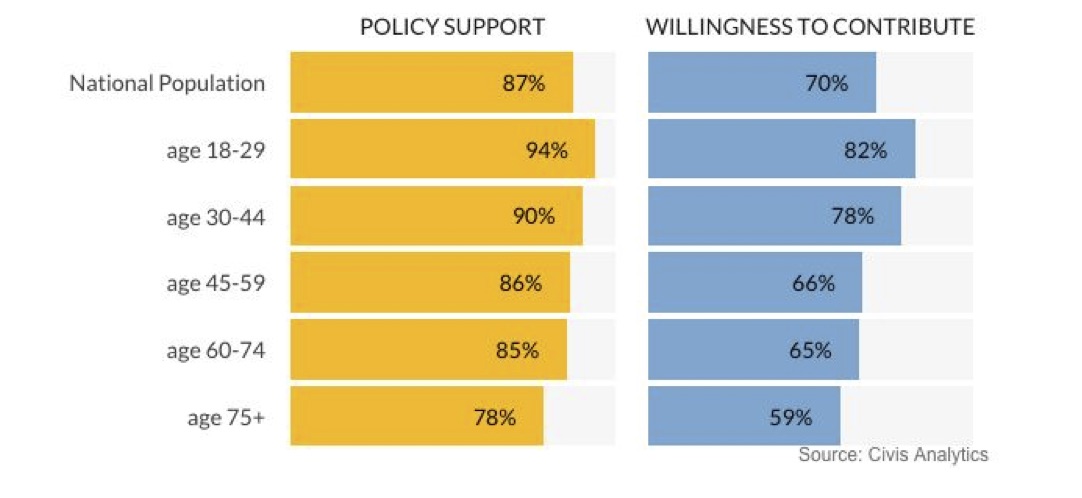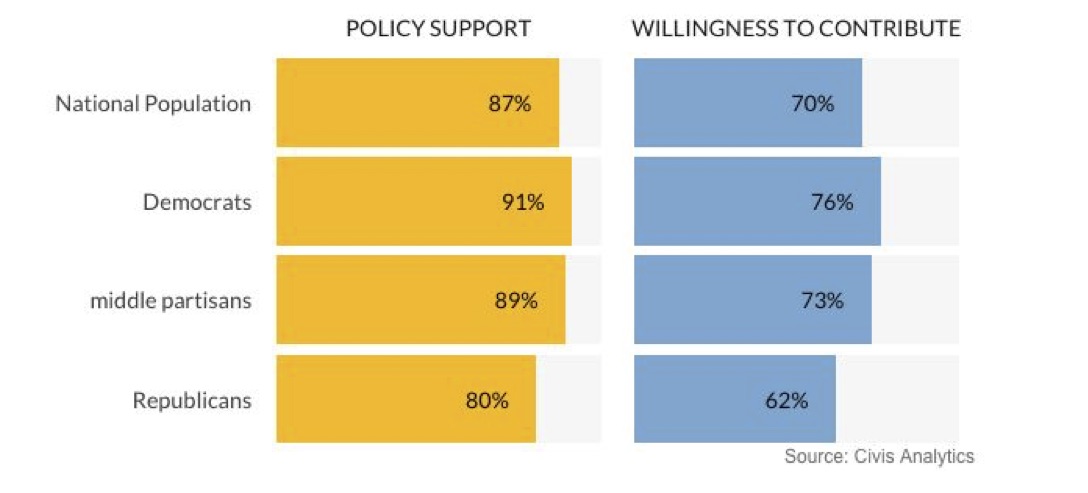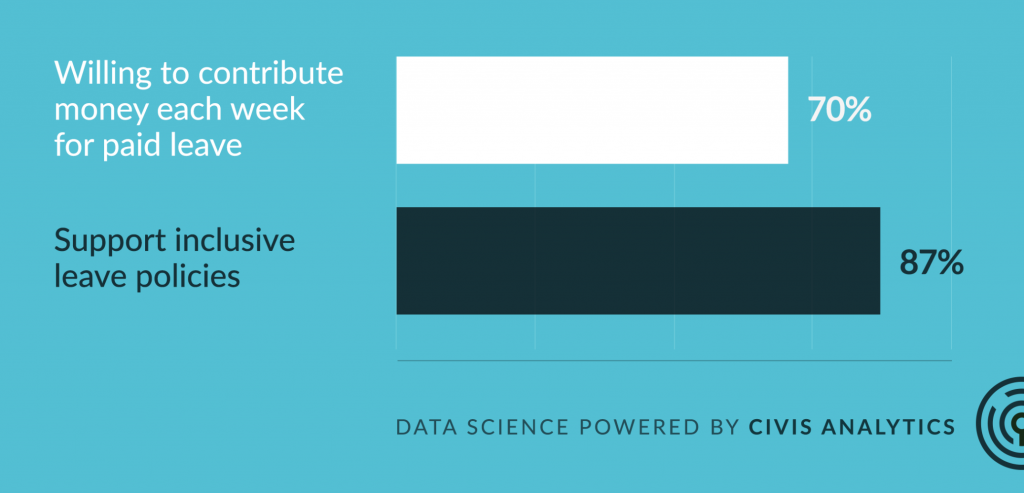This post originally appeared on the Civis Analytics blog.
by Ashley Lagaron Senior Applied Data Scientist
Here’s a hypothetical no-win situation to consider before you read any further: Choosing between your job and your family. You can go to work and keep your paycheck, or stay home to take care of a sick loved one and lose it. Every year, for many American workers, this scary hypothetical becomes an even scarier reality. Now, here’s a realistic dollar amount that could change everything: $1.50.
In November, we launched our second-annual Ask America Anything contest, a Giving Tuesday project in which we gave away two survey questions on our rolling national poll of the U.S. population. This year’s winner was A Better Balance, a national legal advocacy organization dedicated to helping families balance the conflicting demands of work and family. Through advocacy, outreach, and direct legal services, A Better balance works to secure crucial workplace rights such as paid family and medical leave and fairness for pregnant workers
(Last year’s winner was the National Domestic Violence Hotline. You can read about the project we did with them here).
A Better Balance was interested in measuring public support for inclusive paid family and medical leave, which allows workers to be able to afford to take time off to take care of a new child, care for a loved one in poor health, or get treatment for an illness themselves. They also wanted to gauge public willingness to contribute $1.50 per week to cover the cost of such a policy. In January, Sen. Kirsten Gillibrand (D-NY) and Rep. Rosa DeLauro (D-CT) proposed federal legislation to that effect: The Family and Medical Insurance Leave (FAMILY) Act would cost the typical worker $1.50 per week, according to the National Partnership for Women and Families. It would provide 12 weeks of paid leave at 66% of a worker’s wages.
We surveyed U.S. adults, and found that the family leave policies A Better Balance supports are popular nationally, even among groups traditionally less enthusiastic about such policies. About 70% of individuals said they would be willing to contribute $1.50 of their weekly income to support paid family leave. Additionally, public support of inclusive paid leave policies is high, with 87% of respondents saying they would be supportive of paid leave policies that allow time off for many reasons. We found that responses to both questions tended to vary by demographics:
- Parents, younger people, Hispanic and African American respondents, women, and Democrats all tended to be more supportive of paid leave.
- That said, a relatively high number of Republicans are still supportive of these policies. 62% of Republicans said they were willing to contribute part of their income for paid family and medical leave and 80% said they were generally supportive of an inclusive leave policy.
Key Findings
Nationally, members of the general public were highly willing to contribute $1.50 each week for the ability to take paid family or medical year for up to 12 weeks a year.
We found 35% of the public is ‘very willing’ and only about 30% are not very willing or not at all willing to participate in this type of program.
 Additionally, the vast majority (87%) of Americans are at least somewhat supportive of inclusive paid family and medical leave that accommodates different family situations.
Additionally, the vast majority (87%) of Americans are at least somewhat supportive of inclusive paid family and medical leave that accommodates different family situations.
We found 55% ‘strongly support’ a policy that would require employers to allow employees in their state to take temporary paid leave from work and be guaranteed their job back for any of the following reasons:
- For any parent, adoptive or biological, mother or father, to take care for their new child
- To care for a loved one with a serious illness
- To care for themselves if they have a serious illness
 Responses to these two questions were highly correlated, with 57% of those who ‘strongly support’ inclusive paid leave policies saying that they would be ‘very willing’ to contribute $1.50 per week in support of such a policy, compared to only 11% of those who ‘somewhat support’ and 6% of those who ‘somewhat oppose’ paid leave.
Responses to these two questions were highly correlated, with 57% of those who ‘strongly support’ inclusive paid leave policies saying that they would be ‘very willing’ to contribute $1.50 per week in support of such a policy, compared to only 11% of those who ‘somewhat support’ and 6% of those who ‘somewhat oppose’ paid leave.
Demographic Details
Overall, we found that while paid family leave policies were broadly popular, there were some demographic differences in support. In the following charts we show responses to both questions side by side—on the left hand side (in yellow) we show the percent supportive of inclusive family leave policies, and on the right hand side (in blue) we show the percent of individuals who said they would be willing to contribute $1.50 of their income to supporting family leave.
Parents and guardians of children under age 18 were more likely (+8%) to say that they were willing to contribute money each week for paid leave.
 Younger respondents were more likely to say they were willing to contribute some of their income for paid family and medical leave, with 82% of people age 18-29 saying they were at least ‘somewhat’ willing, compared to 59% of those age 75+.
Younger respondents were more likely to say they were willing to contribute some of their income for paid family and medical leave, with 82% of people age 18-29 saying they were at least ‘somewhat’ willing, compared to 59% of those age 75+.
 Willingness to contribute was also associated with gender, with 76% of women reporting they would be willing to contribute, compared to only 64% of of men. Women were also more likely (+10%) than men to be supportive of inclusive leave policies.
Willingness to contribute was also associated with gender, with 76% of women reporting they would be willing to contribute, compared to only 64% of of men. Women were also more likely (+10%) than men to be supportive of inclusive leave policies.
 Willingness to contribute was also correlated with partisanship, with 76% of likely Democrats being somewhat or very willing to contribute, compared to only 62% of likely Republicans.
Willingness to contribute was also correlated with partisanship, with 76% of likely Democrats being somewhat or very willing to contribute, compared to only 62% of likely Republicans.
 Conclusions
Conclusions
We are optimistic that this research will help support A Better Balance in their fight for workplaces inclusive of individuals with diverse family obligations. To learn more about our rolling national poll of the U.S. population, read this info sheet about the Civis Analytics Omnibus Survey.
Methdology
Civis Analytics surveyed 2,383 members of the general public using an online survey from 2016-01-11 to 2017-01-28. Civis pulls samples stratified by key demographic variables from a National Consumer file and subsequently weights responses to the general US population. The results shown in this post are representative of US adults nationally, but state-level results may differ from the national average. The margin of error for these weighted survey results is about +/- 2.0% percentage points. The margin of error varies by cross-tab, with higher margins for breakouts in which there are fewer respondents per category.
Question text
Intro
Some states are proposing a policy that would allow people to take temporary paid leave from their job to bond with a new child, care for a loved one with a serious illness, or to care for themselves due to their own serious illness, paid for by a $1.50 required contribution each week from workers in the state.
Q1
Would you be willing to contribute approximately $1.50 each week if it meant you would be able to take paid family or medical leave for up to 12 weeks a year?
- Very willing
- Somewhat willing
- Not very willing
- Not at all willing
Q2
How much would you support or oppose a policy that would require employers in your state to allow their employees to take temporary paid leave from work and be guaranteed their job back for any of the following reasons:
- For any parent, adoptive or biological, mother or father, to take care for their new child
- To care for a loved one with a serious illness
- To care for themselves if they have a serious illness
- Strongly Support
- Somewhat Support
- Somewhat Oppose
- Strongly Oppose
Ola Topczewska contributed to this research and blog post.
Willingness to contribute was also associated with gender, with 76% of women reporting they would be willing to contribute, compared to only 64% of of men. Women were also more likely (+10%) than men to be supportive of inclusive leave policies.
Willingness to contribute was also correlated with partisanship, with 76% of likely Democrats being somewhat or very willing to contribute, compared to only 62% of likely Republicans.





